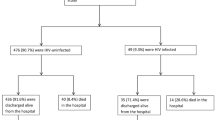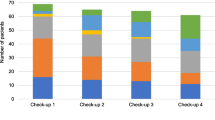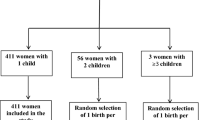Abstract
Pediatric HIV-1 infections are still being diagnosed in France, despite the efficacy of prophylactic treatment to prevent mother-to-child transmission. To describe the characteristics and mode of infection of these children, we retrospectively analysed data of 59 children diagnosed with the HIV-1 infection between January 2000 and June 2005 in a Parisian university hospital. Twenty of these children had been born in France, and none had received appropriate prophylaxis (insufficient, not taken or given too late). Six received no preventive treatment due to failures in screening: three mothers were HIV-seronegative at the start of pregnancy and no test was carried out for the other three. At diagnosis, four had a severe immune deficiency (CD4 cells <15%). The 39 children born abroad were diagnosed at a median age of 3 years (range: 3 months–16 years), sometimes several years after their arrival in France. The clinical, virological and immunological status of these children was poorer than that of the children born in France: 18 had less than 15% CD4 cells. In contrast, the response to treatment of the children born in France was not as good as that of the children born abroad. The HIV-1 screening and prevention programme for pregnant women could be improved. Some children infected following the failure of prevention are at high risk of subsequent treatment failure. HIV-1 infection should be taken into consideration in children born in countries with a high prevalence of HIV, even if they have been living in France for several years and present no symptoms.
Similar content being viewed by others

References
Abrams EJ (2004) Prevention of mother-to-child transmission of HIV-successes, controversies and critical questions. AIDS Rev 6:131–143
Castilla J, Del Romero J, Hernando V, Marincovich B, Garcia S, Rodriguez C (2005) Effectiveness of highly active antiretroviral therapy in reducing heterosexual transmission of HIV. J Acquir Immune Defic Syndr 40:96–101
Chou R, Smits AK, Huffman LH, Fu R, Korthuis PT, US Preventive Services Task Force (2005) Prenatal screening for HIV: A review of the evidence for the U.S. Preventive Services Task Force. Ann Intern Med 143:38–54
Cooper ER, Charurat M, Mofenson L, Hanson IC, Pitt J, Diaz C, et al (2002) Women and Infant’s Transmission Study Group. Combination antiretroviral strategies for the treatment of pregnant HIV-1-infected women and prevention of perinatal HIV-1 transmission. J Acquir Immune Defic Syndr 29:484–94
del Rio C, U.S. Preventive Services Task Force (2005) New USPSTF guidelines on HIV screening. AIDS Clin Care 17:74
European Collaborative Study (2003) Pregnancy-related changes in the longer-term management of HIV-infected women in Europe. Eur J Obstet Gynecol Reprod Biol 111:3–8
European Collaborative Study (2005) Mother-to-child transmission of HIV infection in the era of highly active antiretroviral therapy. Clin Infect Dis 40:458–465
Foster C, Lyall EG (2005) Children with HIV: improved mortality and morbidity with combination antiretroviral therapy. Curr Opin Infect Dis 18:253–259
Hawkins D, Blott M, Clayden P, de Ruiter A, Foster G, Gilling-Smith C, et al (2005) BHIVA Guidelines Writing Committee. Guidelines for the management of HIV infection in 12 pregnant women and the prevention of mother-to-child transmission of HIV. HIV Med 6[Suppl 2]:107–148
Jenista JA (2005) Special topics in international adoption. Pediatr Clin North Am 52:1479–1494
Kelly KA, Harrison CH (2004) Universal prenatal HIV screening: patient attitudes and perceptions. Women Health 40:41–57
King SM; American Academy of Pediatrics Committee on Pediatric AIDS; American Academy of Pediatrics Infectious Diseases and Immunization Committee (2004) Evaluation and treatment of the human immunodeficiency virus-1-exposed infant. Pediatrics 114:497–505
Loutfy MR, Walmsley SL (2004) Treatment of HIV infection in pregnant women: antiretroviral management options. Drugs 64:471–488
Mayaux MJ, Teglas JP, Blanche S, French Pediatric HIV Infection Study Group (2003) Characteristics of HIV-infected women who do not receive preventive antiretroviral therapy in the French Perinatal Cohort. J Acquir Immune Defic Syndr 34:338–343
Morris AB, Dobles AR, Cu-Uvin S, Zorrilla C, Anderson J, Harwell JI, Keller J, Garb J (2005) Protease inhibitor use in 233 pregnancies. J Acquir Immune Defic Syndr 40:30–33
Murray TS, Groth ME, Weitzman C, Cappello M (2005) Epidemiology and management of infectious diseases in international adoptees. Clin Microbiol Rev 18:510–520
Neely M, Kovacs A (2004) Management of antiretroviral therapy in neonates, children, and adolescents. Curr HIV/AIDS Rep 1:97–104
Pearlman DN, Averbach AR, Zierler S, Cranston K (2005) Disparities in prenatal HIV testing: evidence for improving implementation of CDC screening guidelines. J Natl Med Assoc 97[Suppl 7]:44S–51S
Prise en charge thérapeutique des personnes infectées par le VIH. Recommandations du groupe d.experts http://www.sante.gouv.fr/htm/actu/delfraissy_2004/rapport.pdf
Public Health Service Task Force Recommendations for Use of Antiretroviral Drugs in Pregnant HIV-1-Infected Women for Maternal Health and Interventions to Reduce Perinatal HIV-1 Transmission in the United States – November 17, 2005 http://aidsinfo.nih.gov/ContentFiles/PerinatalGL.pdf
Sharland M, Blanche S, Castelli G, Ramos J, Gibb DM, PENTA Steering Committee (2004) PENTA guidelines for the use of antiretroviral therapy, 2004. HIV Med 5:61–86
Surveillance de l.infection à VIH-SIDA en France, 2003–2004. Bulletin Epidémiologique Hebdomadaire 2005;46–47:230–2 (http://www.invs.sante.fr/beh/2005/46_47/beh_46_47_2005.pdf)
Wortley PM, Lindegren ML, Fleming PL (2001) Successful implementation of perinatal HIV prevention guidelines. A multistate surveillance evaluation. MMWR Morb Mort Wkly Rep 11,50(RR-6):17–28
Author information
Authors and Affiliations
Corresponding author
Rights and permissions
About this article
Cite this article
Macassa, E., Burgard, M., Veber, F. et al. Characteristics of HIV-infected children recently diagnosed in Paris, France. Eur J Pediatr 165, 684–687 (2006). https://doi.org/10.1007/s00431-006-0091-6
Received:
Accepted:
Published:
Issue Date:
DOI: https://doi.org/10.1007/s00431-006-0091-6



